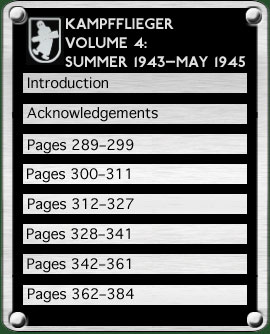|
Follow the link for a lot more on the Luftwaffe's efforts to oppose the Riviera landings.
Werk Nummern and tactical numbers of eleven Fw 190 F-8 and G-3 aircraft serving with III./KG 51 in October/November 1944 and information on AZIMUTH, the unit's temporary deployment in support of Heeresgruppe G. Captions to the photographs on page 348 and the bottom of page 349 (both supplied by the publisher). Marcel van Heijkop points out that this aircraft has none of the characteristic markings of I./KG 66 (however, KG 6 is a possibility). What's more, as is clear from the text, the conventional bomber force was not attacking Britain in August 1944. The caption to photo at the top of the page (supplied by the publisher) contains a typo: this is not a "Ju 188 C" but a Ju 188 A.
Ultra HP 6652 Strength I./KG 66, evening 13th [November 1944]:
Comment: Gruppe due Rhein-Main 4/5th September with 25 Ju 88 S and Ju 188, XL 9278. At Vechta by 6 November, HP 5823 which also associates it with FZG 76. Kommando Schenck (Einsatzkommando KG 51), its operations from Juvincourt in France and transfer to Volkel in Holland. Two Fw 190 G-3 of III./KG 51 were reported to have crashed on the landing area at Bonn-Hangelar on 11 October: W.Nr. 160477, Red 10 (45% damage) W.Nr. 160032, Red 5 (30% damage)
Deciphered German reports on a number of lost or missing Me 262s of I./KG 51; codes of 13 machines of 2./KG 51 and the dates they left Lechfeld in October 1944; codes and/or Werk Nummern of a number of other I./KG 51 jets. Also, reports on the repair of two Kommando Nowotny aircraft at Achmer.
If this aircraft is from Sonderverband Einhorn as the publisher's caption claims, it deepens the mystery of the Staffel’s code system. The two machines that I can confirm as belonging to Einhorn are A3+MA and A3+LX (for the latter, see Ghost Bombers: The Moonlight War of NSG 9, page 103).
I wrote that 15 Ju 88s were delivered to LG 1's "new base at Faßberg" on 19 November. In fact this was more likely just a collection point for the aircraft. Operational airfields for Wacht am Rhein were Varel (I./LG 1) and Ahlhorn (II./LG 1). After retreating to Germany in September, the I. Gruppe had regrouped at Wunsdorf and the II. at Wesendorf. They moved up to operational bases in early and mid-December respectively. Follow this link for information on I./KG 66's role in an operation codenamed Spielzeug. An article on fighter operations by I./KG 51's Me 262s in late November–December 1944, plus other activites by the Geschwader during that period.
The comment in Ultra that the army did not want an attack on Bastogne by LG 1 and I./KG 66 was probably based on the following decrypt issued at 20.48 hours GMT on 24 December 1944: Ultra BT 273 Air operations requirements of (Fair indications XLVII Korps) at 17 hours/24th for 25th: no operation on Bastogne. Attack on town area of Marche … and fighter screen of spearhead of 2. Panzer Division east of Dinant (comment: possibly incomplete). With the benefit of hindsight it can be seen that this message was about daylight fighter and close-support operations for 25 December 1944, not bomber operations on the night of the 24/25th.
Follow the link for more about operations by the Western Front bomber force in the Christmas 1944–New Year 1945 period, including the second raid on Bastogne. The 13 Ju 88 A-4s delivered to LG 1 without exhaust flame dampers were: Werk Nummern 301558, 301515, 300377, 0142183, 0141220, 301550, 301556, 0142185, 301533, 300245, 141038, 142265 and 550459. Another two aircraft were reported as off-strength on 26 December: Werk Nummern 330934 and 330955.
|
|||||||||||||||||||

